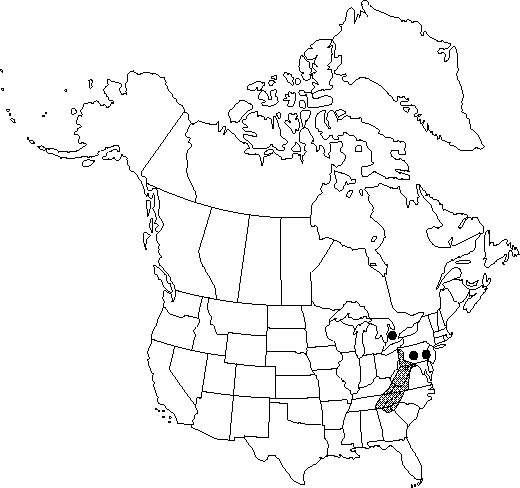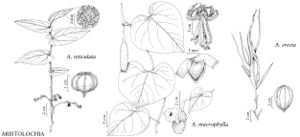Difference between revisions of "Aristolochia macrophylla"
Encycl. 1: 255. 1783.
FNA>Volume Importer |
imported>Volume Importer |
||
| (7 intermediate revisions by 2 users not shown) | |||
| Line 13: | Line 13: | ||
}}{{Treatment/ID/Special_status | }}{{Treatment/ID/Special_status | ||
|code=F | |code=F | ||
| − | |label= | + | |label=Illustrated |
}} | }} | ||
|basionyms= | |basionyms= | ||
| Line 19: | Line 19: | ||
|name=Aristolochia sipho | |name=Aristolochia sipho | ||
|authority=L'Héritier | |authority=L'Héritier | ||
| + | |rank=species | ||
}} | }} | ||
|hierarchy=Aristolochiaceae;Aristolochia;Aristolochia macrophylla | |hierarchy=Aristolochiaceae;Aristolochia;Aristolochia macrophylla | ||
| Line 27: | Line 28: | ||
}}<!-- | }}<!-- | ||
| − | --><span class="statement" id="st- | + | --><span class="statement" id="st-undefined" data-properties=""><b>Lianas,</b> twining, to 20 m, woody. <b>Young</b> stem ribbed, glabrous. <b>Leaves</b>: petiole 4-6 cm. <b>Leaf</b> blade reniform, 7-34 × 10-35 cm, base cordate, sinus depth 1-4.5 cm, apex obtuse to acute or acuminate; surfaces abaxially glabrous to slightly puberulent; venation palmate-pinnate. <b>Inflorescences</b> on new growth, axillary, solitary flowers; peduncle bracteolate, 3-7 cm; bracteoles reniform, to 15 mm. <b>Flowers</b>: calyx yellow-brown marked with red-brown, strongly curved; utricle pendent, globose to cylindric, 0.5-1.5 × 0.8-1 cm; syrinx absent; tube curved or bent and angled upward, cylindric, 1-3 × 0.3-0.5 cm; annulus smooth; limb yellow to brown, 3-lobed, lobes 1.5-2 × 1.5-2 cm, glabrous; gynostemium 3-lobed, globose to crown-shaped, 4 mm; anthers 6; ovary 3-locular, 3-7 cm. <b>Capsule</b> ovoid to cylindric, 6-8 × 4-10 cm, dehiscence basipetal; valves 6; septa entire, not attached to valves. <b>Seeds</b>* flat, triangular, 1 × 1 cm. <b>2n</b> = 28.</span><!-- |
-->{{Treatment/Body | -->{{Treatment/Body | ||
| Line 34: | Line 35: | ||
|elevation=50-1300 m | |elevation=50-1300 m | ||
|distribution=Ont.;Ga.;Ky.;Md.;N.C.;Pa.;S.C.;Tenn.;Va.;W.Va. | |distribution=Ont.;Ga.;Ky.;Md.;N.C.;Pa.;S.C.;Tenn.;Va.;W.Va. | ||
| − | |discussion=<p>Aristolochia macrophylla has possibly escaped from cultivation in Connecticut, Maryland, Massachusetts, New Jersey, New York, and Vermont; these are not documented.</p><!-- | + | |discussion=<p><i>Aristolochia macrophylla</i> has possibly escaped from cultivation in Connecticut, Maryland, Massachusetts, New Jersey, New York, and Vermont; these are not documented.</p><!-- |
| − | --><p>The name Aristolochia durior Hill has been misapplied to this species.</p><!-- | + | --><p>The name <i>Aristolochia</i> durior Hill has been misapplied to this species.</p><!-- |
| − | --><p>The Cherokee applied decoctions made from the roots of Aristolochia macrophylla directly to feet and legs to alleviate swelling; they ingested a compound infusion of "stalk chips" for yellowish urine (D. E. Moerman 1986).</p><!-- | + | --><p>The Cherokee applied decoctions made from the roots of <i>Aristolochia macrophylla</i> directly to feet and legs to alleviate swelling; they ingested a compound infusion of "stalk chips" for yellowish urine (D. E. Moerman 1986).</p><!-- |
| − | --><p>The leaves of Aristolochia macrophylla are eaten by larvae of the eastern pipe-vine swallowtail butterfly, Battus philenor philenor (Linnaeus) (W. H. Howe 1975).</p> | + | --><p>The leaves of <i>Aristolochia macrophylla</i> are eaten by larvae of the eastern pipe-vine swallowtail butterfly, Battus philenor philenor (Linnaeus) (W. H. Howe 1975).</p> |
|tables= | |tables= | ||
|references= | |references= | ||
| Line 46: | Line 47: | ||
-->{{#Taxon: | -->{{#Taxon: | ||
name=Aristolochia macrophylla | name=Aristolochia macrophylla | ||
| − | |||
|authority=Lamarck | |authority=Lamarck | ||
|rank=species | |rank=species | ||
| Line 60: | Line 60: | ||
|publication title=Encycl. | |publication title=Encycl. | ||
|publication year=1783 | |publication year=1783 | ||
| − | |special status=Endemic; | + | |special status=Endemic;Illustrated |
| − | |source xml=https:// | + | |source xml=https://bitbucket.org/aafc-mbb/fna-data-curation/src/2e0870ddd59836b60bcf96646a41e87ea5a5943a/coarse_grained_fna_xml/V3/V3_968.xml |
|genus=Aristolochia | |genus=Aristolochia | ||
|species=Aristolochia macrophylla | |species=Aristolochia macrophylla | ||
| − | |||
| − | |||
| − | |||
| − | |||
| − | |||
| − | |||
| − | |||
| − | |||
| − | |||
| − | |||
| − | |||
| − | |||
| − | |||
| − | |||
| − | |||
| − | |||
| − | |||
| − | |||
| − | |||
| − | |||
| − | |||
| − | |||
| − | |||
| − | |||
| − | |||
| − | |||
| − | |||
| − | |||
| − | |||
| − | |||
| − | |||
| − | |||
| − | |||
| − | |||
| − | |||
| − | |||
| − | |||
| − | |||
| − | |||
| − | |||
| − | |||
| − | |||
| − | |||
| − | |||
| − | |||
| − | |||
| − | |||
| − | |||
| − | |||
| − | |||
| − | |||
| − | |||
| − | |||
| − | |||
| − | |||
}}<!-- | }}<!-- | ||
-->[[Category:Treatment]][[Category:Aristolochia]] | -->[[Category:Treatment]][[Category:Aristolochia]] | ||
Latest revision as of 22:52, 5 November 2020
Lianas, twining, to 20 m, woody. Young stem ribbed, glabrous. Leaves: petiole 4-6 cm. Leaf blade reniform, 7-34 × 10-35 cm, base cordate, sinus depth 1-4.5 cm, apex obtuse to acute or acuminate; surfaces abaxially glabrous to slightly puberulent; venation palmate-pinnate. Inflorescences on new growth, axillary, solitary flowers; peduncle bracteolate, 3-7 cm; bracteoles reniform, to 15 mm. Flowers: calyx yellow-brown marked with red-brown, strongly curved; utricle pendent, globose to cylindric, 0.5-1.5 × 0.8-1 cm; syrinx absent; tube curved or bent and angled upward, cylindric, 1-3 × 0.3-0.5 cm; annulus smooth; limb yellow to brown, 3-lobed, lobes 1.5-2 × 1.5-2 cm, glabrous; gynostemium 3-lobed, globose to crown-shaped, 4 mm; anthers 6; ovary 3-locular, 3-7 cm. Capsule ovoid to cylindric, 6-8 × 4-10 cm, dehiscence basipetal; valves 6; septa entire, not attached to valves. Seeds* flat, triangular, 1 × 1 cm. 2n = 28.
Phenology: Flowering late spring–summer.
Habitat: Forests, often on dissected uplands and rugged, rocky slopes, Cumberland and Blue Ridge mountains
Elevation: 50-1300 m
Distribution

Ont., Ga., Ky., Md., N.C., Pa., S.C., Tenn., Va., W.Va.
Discussion
Aristolochia macrophylla has possibly escaped from cultivation in Connecticut, Maryland, Massachusetts, New Jersey, New York, and Vermont; these are not documented.
The name Aristolochia durior Hill has been misapplied to this species.
The Cherokee applied decoctions made from the roots of Aristolochia macrophylla directly to feet and legs to alleviate swelling; they ingested a compound infusion of "stalk chips" for yellowish urine (D. E. Moerman 1986).
The leaves of Aristolochia macrophylla are eaten by larvae of the eastern pipe-vine swallowtail butterfly, Battus philenor philenor (Linnaeus) (W. H. Howe 1975).
Selected References
None.
